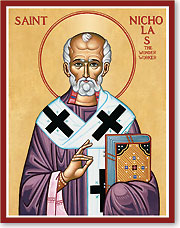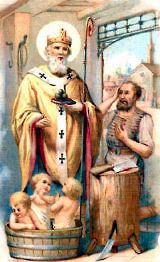 Remembered each year most especially during the month of December, his white-bearded face is familiar to and beloved by all. Defying the limits of space and time, his benevolent assistance and generosity to children and people of all ages is legendary throughout the world.
Remembered each year most especially during the month of December, his white-bearded face is familiar to and beloved by all. Defying the limits of space and time, his benevolent assistance and generosity to children and people of all ages is legendary throughout the world.
This description, of course, fits both Santa Claus and Saint Nicholas. The latter antedates the former, so let's consider how Saint Nicholas came to be identified as the figure we now know as Santa Claus.
His story
Our saint was born during the third century in the village of Patara. At the time the area was Greek and is now on the southern coast of Turkey. His wealthy parents, who raised him to be a devout Christian, died in an epidemic while Nicholas was still young. Obeying Jesus' words to "sell what you own and give the money to the poor," Nicholas used his whole inheritance to assist the needy, the sick, and the suffering. He dedicated his life to serving God and was made Bishop of Myra while still a young man. Bishop Nicholas became known throughout the land for his generosity to the those in need, his love for children, and his concern for sailors and ships.
 Under the Roman Emperor Diocletian, who ruthlessly persecuted Christians, Saint Nicholas suffered for his faith, was exiled and imprisoned. The prisons were so full of bishops, priests, and deacons, there was no room for the real criminals—murderers, thieves and robbers. After his release, Saint Nicholas attended the Council of Nicaea in 325. He died December 6, 343 in Myra and was buried in his cathedral church, where a unique relic, called manna, formed in his grave. This fragrant liquid substance with its miraculous healing powers fostered the growth of devotion to the saint. The anniversary of his death became a day of celebration, Saint Nicholas Day, December 6th.
Under the Roman Emperor Diocletian, who ruthlessly persecuted Christians, Saint Nicholas suffered for his faith, was exiled and imprisoned. The prisons were so full of bishops, priests, and deacons, there was no room for the real criminals—murderers, thieves and robbers. After his release, Saint Nicholas attended the Council of Nicaea in 325. He died December 6, 343 in Myra and was buried in his cathedral church, where a unique relic, called manna, formed in his grave. This fragrant liquid substance with its miraculous healing powers fostered the growth of devotion to the saint. The anniversary of his death became a day of celebration, Saint Nicholas Day, December 6th.
An icon of benevolence
There are several stories of Saint Nicholas that have survived the centuries, which will help us understand his extraordinary character and why he is so beloved and revered as protector and helper of those in need.
Gift-giver and Protector of the Poor
At the time of Saint Nicholas there was a poor man who had three daughters, who, without dowries, were therefore destined to be sold into slavery. Mysteriously, on three different occasions, a bag of gold appeared in their home-providing the needed dowries. The bags of gold, tossed through an open window, are said to have landed in stockings or shoes left before the fire to dry.
This led to the custom of children hanging stockings or putting out shoes, eagerly awaiting gifts from Saint Nicholas. Sometimes the story is told with gold balls instead of bags of gold. That is why three gold balls, sometimes represented as oranges, are one of the symbols for St. Nicholas. And so St. Nicholas is a gift-giver.
A miraculous intercession
Sometime after Saint Nicholas had left this world the townspeople of Myra were celebrating the saint on the eve of his feast day when a band of Arab pirates from Crete came into the district. They stole treasures from the Church of Saint Nicholas to take away as booty. As they were leaving town, they snatched a young boy, Basilios, to make into a slave.
The emir, or ruler, selected Basilios to be his personal cupbearer, as not knowing the language, Basilios would not understand what the king said to those around him. So, for the next year Basilios waited on the king, bringing his wine in a beautiful golden cup. For Basilios' parents, devastated at the loss of their only child, the year passed slowly, filled with grief.
As the next St. Nicholas' feast day approached, Basilios' mother would not join in the festivity, as it was now a day of tragedy. However, she was persuaded to have a simple observance at home—with quiet prayers for Basilios' safekeeping. Meanwhile, as Basilios was fulfilling his tasks serving the emir, he was suddenly whisked up and away. Saint Nicholas appeared to the terrified boy, blessed him, and set him down at his home back in Myra.
Imagine the joy and wonderment when Basilios amazingly appeared before his parents, still holding the king's golden cup. This is the first story told of St. Nicholas protecting children—which became his primary role in the West.
Protector of Youths and Travelers
 Three theological students were traveling on their way to study in Athens. A wicked innkeeper robbed and murdered them, hiding their remains in a large pickling tub. Saint Nicholas, traveling along the same route, stopped at this very inn. In the night he dreamed of the crime, got up, and summoned the innkeeper. As Saint Nicholas prayed earnestly to God the three boys were restored to life and wholeness.
Three theological students were traveling on their way to study in Athens. A wicked innkeeper robbed and murdered them, hiding their remains in a large pickling tub. Saint Nicholas, traveling along the same route, stopped at this very inn. In the night he dreamed of the crime, got up, and summoned the innkeeper. As Saint Nicholas prayed earnestly to God the three boys were restored to life and wholeness.
In France the story is told of three small children, wandering in their play until lost, lured, and captured by an evil butcher. Saint Nicholas appeared and appealed to God to return them to life and to their families. And so Saint Nicholas is the patron and protector of children.
Saint Nicholas and the Origin of Saint Claus
The first Europeans to arrive in the New World brought St. Nicholas. Vikings dedicated their cathedral to him in Greenland. On his first voyage, Columbus named a Haitian port for St. Nicholas on December 6, 1492. In Florida, Spaniards named an early settlement St. Nicholas Ferry, now known as Jacksonville. However, St. Nicholas had a difficult time during the 16th century Protestant Reformation which took a dim view of saints. Even though both reformers and counter-reformers tried to stamp out St. Nicholas-related customs, they had very little long-term success except in England where the religious folk traditions were permanently altered. Because the common people so loved St. Nicholas, he survived on the European continent as people continued to place nuts, apples, and sweets in shoes left beside beds, on windowsills, or before the hearth.
After the American Revolution, John Pintard, the influential patriot and antiquarian who founded the New York Historical Society in 1804, promoted St. Nicholas as patron saint of both society and city. In January 1809, Washington Irving joined the society and on St. Nicholas Day that same year, he published the satirical fiction, Knickerbocker's History of New York, with numerous references to a jolly St. Nicholas character. This was not the saintly bishop, rather an elfin Dutch burgher with a clay pipe. These flights of imagination are the source of the New Amsterdam St. Nicholas legends: that the first Dutch emigrant ship had a figurehead of St. Nicholas: that St. Nicholas Day was observed in the colony; that the first church was dedicated to him; and that St. Nicholas comes down chimneys to bring gifts. Irving's work was regarded as the "first notable work of imagination in the New World."
The New York Historical Society held its first St. Nicholas anniversary dinner on December 6, 1810. John Pintard commissioned artist Alexander Anderson to create the first American image of Nicholas for the occasion. Nicholas was shown in a gift-giving role with children's treats in stockings hanging at a fireplace.
1821 brought some new elements with publication of the first lithographed book in America, the Children's Friend. This "Sante Claus" arrived from the North in a sleigh with a flying reindeer. The annonymous poem and illustrations proved pivital in shifting imagery away from a saintly bishop. Sante Claus rewarded good behavior with gifts and punished bad conduct by leaving a "long, black birchen rod . . . direct(ing) a Parent's hand to use when virtue's path his sons refuse." The book also notably marked S. Claus' first appearance on Christmas Eve, rather than December 6th.
The jolly elf image received another big boost in 1823, from a poem destined to become immensely popular, "A Visit from St. Nicholas," now better known as "The Night Before Christmas."
Other artists and writers continued the change to an elf-like St. Nicholas, "Sancte Claus," or "Santa Claus," unlike the stately bishop saint. In 1863, during the Civil War, political cartoonist Thomas Nast began a series of annual black-and-white drawings in Harper's Weekly, based on the descriptions found in the poem and Washington Irving's work. These drawings established a rotund Santa with flowing beard, fur garments, and an omnipresent clay pipe. Nast's Santa supported the Union and President Lincoln believed this contributed to the Union troops' success by demoralizing Confederate soldiers. As Nast drew Santas until 1886, his work had considerable influence in forming the American Santa Claus. Along with appearance changes, the saint's name shifted to Santa Claus—a natural phonetic alteration from the German Sankt Niklaus.
It's been a long journey from the Fourth Century Bishop of Myra, St. Nicholas, who showed his devotion to God in extraordinary kindness and generosity to those in need, to America's jolly Santa Claus, whose largesse often supplies luxuries to the affluent. However, if you peel back the accretions, he is still Nicholas, Bishop of Myra, whose caring surprises continue to model true giving and faithfulness.